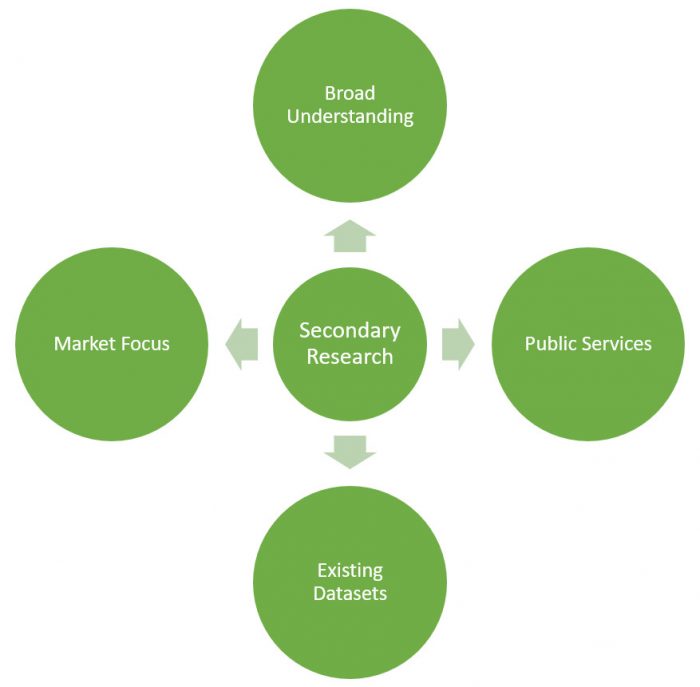Secondary research refers to the use of existing data to answer research questions or solve research problems. There are many situations where taking this approach can be of benefit, and in this article, we outline some of the key features and types of secondary research and why there are advantages to following this route rather than gathering your own data.

Secondary Research design and types
Secondary research, also known as desk research, is undertaken by collating existing data online or from journals, books and public sources such as government archives and libraries. The design of the research means that the researcher pulls together a range of different data samples and collates them in a systematic way to achieve their research conclusions. The aim is to examine and evaluate established patterns from previous (or a priori) sources and apply these to their own research context.
In most cases the secondary researchers are reliant on data that was previously gathered from primary research and can be used to evaluate and identify gaps in existing knowledge. As a result, secondary research studies are frequently the foundation for subsequent primary research works which examine these identified gaps.
Common Secondary Research Sources
Once you understand that secondary research requires the assimilation and collation of data from potentially varied sources, then you can recognise that this new pool of data can deliver potentially new insights. Common sources of secondary data include online sources, libraries, archives, commercial and organisational reports as well as peer-reviewed journals and textbooks.
Online data
Online data gathering is a highly popular method for secondary research, which gives access to a high volume of both free and paid sources that can be easily gathered by the researcher. Indeed, it can be suggested that online sources bring together, at the click of a button, all the other potential sources of data for secondary research.
Government and Other Archives
Useful research can be found in government archives which are considered verifiable and trustworthy, and as a result can be used to identify insights on a range of research contexts. Care should be taken however not to try and access classified information.
Libraries and Educational Institutions
Public and private libraries are highly valuable sources of information. In particular many hold copies of dissertations, donated by researchers and students. In addition, libraries are an excellent source for commercial research and business reports. Similar to libraries are educational institutions which frequently have copies of a range of primary research that they may be willing to share to further knowledge and understanding in particular area.
Types of Secondary Research
Similar to primary research, secondary research may also be qualitative or quantitative, or a mix of both approaches. Qualitative secondary data is generally interviews or focus groups which can be used to gain more in-depth insights into a research problem or business question. Quantitative data in contrast is focused on gathering statistical data from surveys, questionnaires and business trends.
Advantages of Secondary Research
The biggest advantage of secondary research is that in most cases the data is easy to access, particularly when gathering data from online sources. More traditional secondary research sources such as libraries or government archives are also easy to access. This saves the researcher a great deal of time and allows for a potentially wider dataset to be gathered.
Equally important to many researchers is that secondary research is cost-effective, as there is no direct data collection from a cohort.
A major value in utilising secondary research is that it allows a researcher at an early stage of investigation to identify knowledge gaps in a study area. In other words, it can be used to present initial thoughts before embarking on a longer study and the collection of primary data.
Alongside identification of knowledge gaps, undertaking secondary research at the outset of an investigation can potentially identify that the planned work has already been undertaken and the information the researcher hoped to gain is already available. This can eliminate the need for undertaking time-intensive and costly primary research. Read about the disadvantages of primary research.
An additional potential benefit of utilising secondary research is that in many cases, the data is already in the public domain and thus permission for usage or consent from participants is not required. In addition, provided the secondary data is used appropriately, there is frequently less concerns about potential ethical violations in the conduct of the research.
When should I use secondary research?
There are a number of scenarios when secondary research may be viable:
- When the purpose of the proposed work is to identify gaps in knowledge.
- When the study to be undertaken is building on an existing work and seeks not to find new outcomes but is designed to look at new trends and relationships in existing data sets.
- When the researcher has an existing view on what their outcomes may be and is aware that there is authentic data already available (for example, industry or government reports which are viewed as credible sources).
- There has been a recent data collection of information that is applicable to the study aims and it would not be economical or viable to collect new data. This is a major advantage of using secondary research, particularly in existing fields of study.
Whatever your research question or problem is, in most cases there is a wide body of knowledge and potential datasets that can be collated and used to provide initial responses. So, if you’re looking for easy-to-access data for your essay or dissertation, secondary research may be the right option for you!